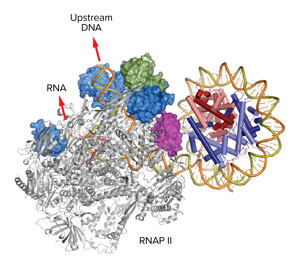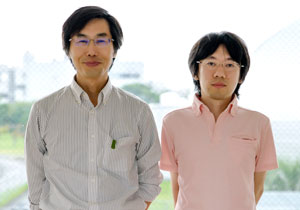Apr. 12, 2019 Research Highlight Biology
Elongation factors smooth transcription in the nucleosome
The smooth copying of genetic information in cells is facilitated by two protein factors that act as bearings against chromatin structures
 Figure 1: The elongation factors Elf1 (magenta) and Spt4/5 (blue and green) come between RNA polymerase II (RNAP II) and a nucleosome to ensure smooth transcription of DNA. From Ref. 1. Reprinted with permission from AAAS.
Figure 1: The elongation factors Elf1 (magenta) and Spt4/5 (blue and green) come between RNA polymerase II (RNAP II) and a nucleosome to ensure smooth transcription of DNA. From Ref. 1. Reprinted with permission from AAAS.
Two protein factors play a critical role in ensuring that transcription of DNA into RNA does not grind to a temporary standstill when it hits structures known as nucleosomes, RIKEN researchers have shown1. This finding has important implications for research into new strategies for treating diseases.
As you read this, an enzyme known as RNA polymerase II is busy transcribing genetic information stored in DNA into messenger RNA, much of which is then converted into proteins needed for various cellular processes in your body.
The familiar double helix of DNA is not arranged in straight lengths; rather, it is wrapped around spool-like structures known as nucleosomes, which are connected by short, linear sections of DNA. While this arrangement allows more compact storage of DNA than a linear structure, it complicates transcription because RNA polymerase II has to negotiate nucleosomes—the building blocks of chromatin—when it is transcribing.
“How RNA polymerase II manages to do this has been a long-standing question in cell biology,” says Shun-ichi Sekine of the RIKEN Center for Biosystems Dynamics Research (BDR).
When proteins called elongation factors are not present, the transcription of DNA by RNA polymerase II stalls at several locations within the nucleosome, a previous study by Sekine and collaborators had shown.
 Shun-ichi Sekine (left) and Haruhiko Ehara (right) have found that elongation factors Elf1 and Spt4/5 prevent RNA polymerase II from stalling when transcribing in the nucleosome. © 2019 RIKEN
Shun-ichi Sekine (left) and Haruhiko Ehara (right) have found that elongation factors Elf1 and Spt4/5 prevent RNA polymerase II from stalling when transcribing in the nucleosome. © 2019 RIKEN
Now, they have identified two particular elongation factors—Elf1 and Spt4/5—that prevent RNA polymerase II from stalling. By examining the structures of Elf1 and Spt4/5, the team has also revealed some of their inner workings.
The researchers found that by itself Elf1 did not prevent transcription from stalling, while Spt4/5 had only a limited effect. But when both elongation factors were present, transcription proceeded unimpeded. “This was a very surprising finding,” says Haruhiko Ehara, also of BDR. “Especially for the small Elf1 factor, since very little was known about it.”
The team then used cryo-electron microscopy to examine the structures of these two elongation factors and how they help RNA polymerase II to pass through the nucleosome. They discovered that Elf1 and Spt4/5 squeeze in between RNA polymerase II and the nucleosome and effectively act as bearings, enabling transcription to occur smoothly. “The two elongation factors prevent direct contact between the polymerase and the nucleosomes that cause stalling, and they facilitate the smooth rotation of the nucleosome in front of RNA polymerase II,” notes Sekine.
This information will be foundational for future research into diseases such as cancers that involve the improper transcription of genetic information. “By studying such structures we can gain a better understanding of disease mechanisms, which will provide valuable clues for drug development and other therapies,” says Sekine.
Related contents
- Molecular structure of elongation complex essential for DNA transcription determined
- How DNA traffic jams cause cell differences
References
- 1. Ehara, H., Kujirai, T., Fujino, Y., Shirouzu, M., Kurumizaka, H. & Sekine, S. Structural insight into nucleosome transcription by RNA polymerase II with elongation factors. Science 363, 744–747 (2019). doi: 10.1126/science.aav8912
